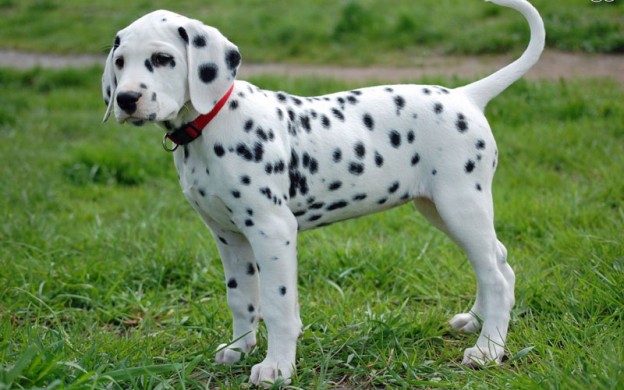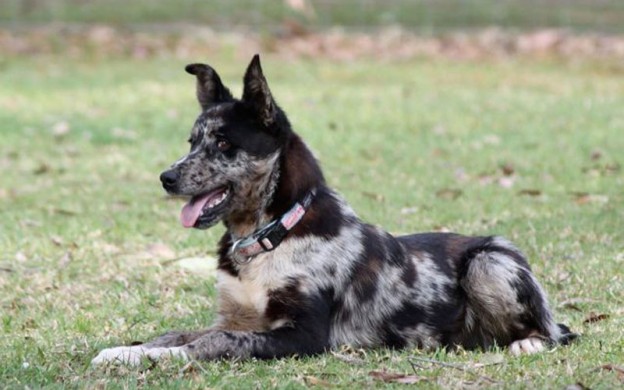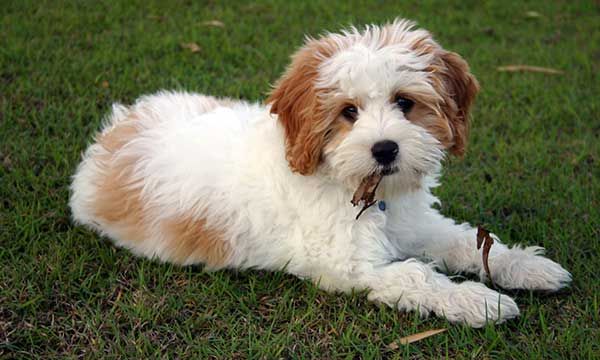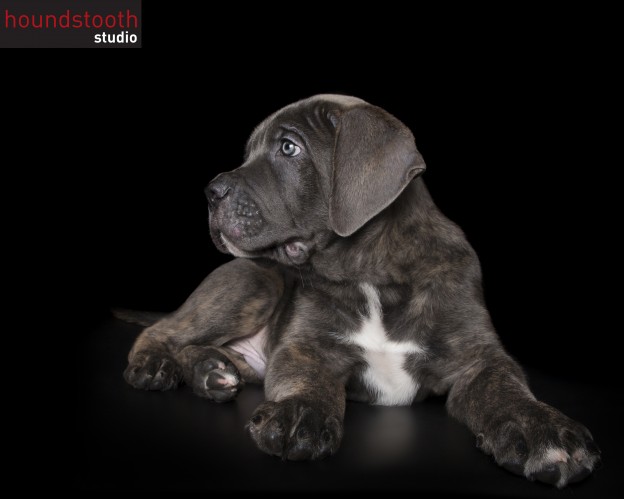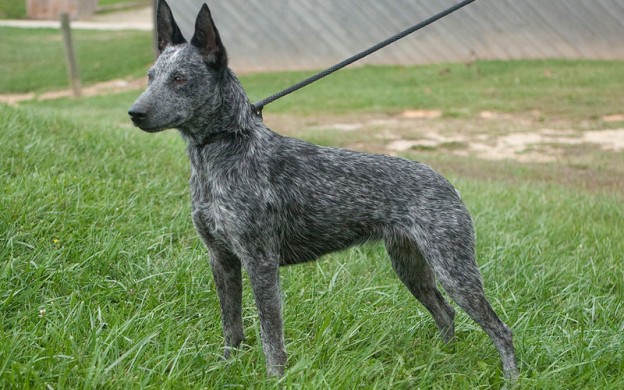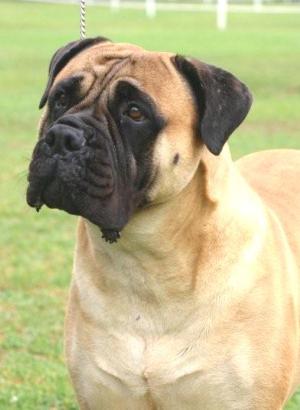
The Bullmastiff is an alert, loyal and intelligent companion, that loves to jump over fences!
Facts
Personality: High spirited, very good temperament, level-headed attitude, alert, faithful, docile, intelligent, territorial, likes to lay about and can be stubborn.
Backyard requirements: Normal-sized backyard with a sturdy fence, preferably 5’6″ as they have been known to jump over high fences. Large backyard or country space is preferable if you have more than one dog.
Health problems: Cancer, heart murmurs, bloat, hip and elbow dysplasia.
Watchdog qualities: Excellent. It knows when and when not to bark. Has good protection and guarding instincts and will alert you to danger.
Exercise requirements: Careful that you don’t exercise your puppy too much as high-impact exercise and running is not recommended for puppies until well over 18 months old. If you must walk your puppy, start with short and slow strolls.
The Bullmastiff is a loveable large breed with a heart of gold. It has great guarding capabilities while being a loyal, loving companion.
Watch out, this dog is able to knock you down in a single bound and can leap high fences in a single jump! Despite its imposing size and bully-dog looks, the Bullmastiff is really a calm, gentle and level-headed pooch. Breeders describe the Bullmastiff as an excellent companion and guard dog and most value it for its quiet virtues. It is not much of a barker and will only bark if necessary. The Bullmastiff should not be confused with the much larger Mastiff, also called the English Mastiff. The Bullmastiff is a separate breed, originating in England in the early to middle 1800s.
History
he history of the breed is an interesting and purposeful one. As a number of private estates got larger and larger in early 19th-century England, it became increasingly difficult for gamekeepers to patrol and keep poachers under control. Punishment for poaching on private property was very severe in those days, in some cases punishable by death. As rewards for poaching became higher and more attractive, poachers took more risks and the crime ultimately became more dangerous. This lead to estate gamekeepers keeping powerful dogs that could track down and help them confront and hold the poachers.
Initially they tested the Mastiff but found it to be too slow and not agile enough. They then trialled the smaller Bulldog but found it too vicious. These dogs tended to wound their victims rather badly, sometimes even mortally.
The ideal breed for the task came in the form of the Bullmastiff, a cross between the two earlier breeds. It proved to be the best dog for the job — quiet enough to track the poacher and fast and powerful enough to pounce on and keep the perpetrator down until the handler came. The beauty of this breed is that its instinct is not to bite, but to hold down.
Because of its history, the Bullmastiff is also called the “gamekeeper’s dog”. As larger estates got broken down into smaller lots and sold off, the need for Bullmastiffs as tracking and guard dogs declined. Today, they fit in remarkably well with families as companions and guard dogs.
Characteristics
Although the true mixture of the Bullmastiff is 60 per cent Mastiff and 40 per cent Bulldog, it seems the English preferred their Bullmastiff with a 50/50 combination while the Americans and Australians preferred 60/40 Mastiff and Bulldog cross. Bullmastiffs are intelligent, stubborn, fearless, possess good watchdog instincts, are quiet, alert and faithful.
This giant is surprisingly good with young children, but be careful around small kids as this breed grows very quickly and in its excitement can knock down kids accidentally during playtime. Breeders Kath and Barry Marion and Nikki Marshall advise that children and dog should be taught to respect each other.
Something to remember is that although the puppy may be adult-sized, it is still a puppy! Firm obedience training, education and dog-friendly playtime should be encouraged and taught as early as possible. This breed responds to firm obedience training and it’s best to start as early as possible. They’re very strong dogs and it would be wise to get the dog to respond to you as soon as possible. Remember, you should always supervise your children when playing with dogs, no matter what the breed.
According to the Marions, who have been breeding for more than 20 years, Bullmastiffs are territorial and don’t always put out the welcome mat for other strange dogs (they’re good if they’ve grown up with other animals) or strangers. One good way to get your dog to accept your guests is to welcome your guests and introduce them to your dog, letting your dog slowly approach and sniff their legs. Bullmastiffs may take a while to approach a guest so it’s best not to rush towards the dog. Let it come to you first. When it comes to strangers, Nikki agrees that a bonus with the Bullmastiff is its impressive size, which is always a good deterrent to intruders.
But the coat is so short. Do I still need to maintain it?
Bullmastiffs shed quite a bit of their coat so regular brushing is recommended. Kath and Barry say their dogs shed mostly in spring and depending on how dirty they are, they are bathed about three times a month. They use a rubber horse curry brush after a bath to get rid of those loose hairs.
Some dogs moult badly but Kath says this is quite natural as the new coat comes through a shade darker, giving the coat a mottled look. If you don’t want to bathe your dog, Nikki has some good tips for dry bathing. She rubs down the dogs thoroughly with warm water and a small amount of disinfectant to rid the coat of dust. She says you shouldn’t always give your dog a full shampoo wash as that can strip the coat of its natural protective oils and can make it susceptible to skin problems, such as hot spots.
Kath and Barry remind us to check the dog’s ears as well and clean them regularly; if they start shaking their ears incessantly, it could mean they have grass seeds in their ears. Take your dog to the vet if you are unsure.
Things to remember
Bullmastiffs do no like the heat so take them for their walk in the morning or in the evenings. The Marions’ dogs love the coolness of the cement kennel floors in summer, when temperatures really soar. They have also installed water mist sprays across the top of the kennels which spray a fine mist over the dogs when it’s very hot.
And not too much lazing about, please! Don’t forget that without proper exercise and stimulation, Bullmastiffs can turn into fat couch potatoes just like humans. If you keep your dog in a small backyard, make sure it gets enough exercise.
Kath warns that while it is tempting to stuff your pup as much as you can because you think it will make it grow faster, this can backfire. Instead, you could end up with a fat, greedy and often unhealthy puppy. Kath says that you should be able to see the last rib on an adult dog or bitch.
Though there is no hard and fast rule as to what to feed your dogs, you might want to try some of these breeders’ dietary tips. Kath and Barry recommend that you feed your dogs a low-protein diet through the summer months to prevent your dogs developing skin problems. “Ours are lucky. They have plenty of fruit in their diets through the summer as we have lots of fruit trees. They love their treats of apricots, plums, apples and figs,” says Kath. Nikki has experimented with feeding her dogs solely on the BARF diet but found they needed the bulk of a good-quality dry food as well. She recommends that an all-natural, colour-free dry food is best, supplemented with raw chicken carcasses minced up with vegetables, pasta, egg and red meat if you have time.
Like a lot of large, deep-chested breeds, the Bullmastiff can suffer from bloat. This occurs most commonly after vigorously exercising your dog several hours after a meal. Make sure that if you want to walk your dog after a meal, do it slowly and gently or exercise before a meal. Hip, elbow dysplasia, kidney disease, thyroid problems, heart murmurs and certain cancers are some of the more common problems prevalent in the breed. All honest breeders should have their stock hip X-rayed and scored before breeding. Always ask your breeder if their stock is hip scored and X-rayed if you’re not sure.
The only disadvantage to this breed is that it has a short lifespan, living up to 10 years. So make all those formative, fun and productive years with your Bullmastiff count. Both breeders testify to the joys of owning this pooch and like any addiction, once you have one, you just can’t stop.
Breed Care
Daily: Fresh water and a good balanced diet.
Weekly: A brush with a rubber or slicker brush to promote good skin and coat.
Monthly: Heartworm, gastrointestinal and flea prevention. Also check the nails to see if they need to be clipped and wipe inside the ears. Bath once a month or when required.
Regular: This breed loves to get out and about with their owners and will really enjoy a good off-leash run at least once a week. Walking daily with the dog is a requirement.
Breed Contacts
If you would like to find out more about this breed and watch some of these dogs in action, please contact the club in your state for weekend show details.



